[English] 日本語
 Yorodumi
Yorodumi- PDB-1b0g: CLASS I HISTOCOMPATIBILITY ANTIGEN (HLA-A2.1)/BETA 2-MICROGLOBULI... -
+ Open data
Open data
- Basic information
Basic information
| Entry | Database: PDB / ID: 1b0g | |||||||||
|---|---|---|---|---|---|---|---|---|---|---|
| Title | CLASS I HISTOCOMPATIBILITY ANTIGEN (HLA-A2.1)/BETA 2-MICROGLOBULIN/PEPTIDE P1049 COMPLEX | |||||||||
 Components Components |
| |||||||||
 Keywords Keywords |  HISTOCOMPATIBILITY ANTIGEN / CLASS I HISTOCOMPATIBILITY ANTIGEN (HLA-A2.1)-BETA 2-MICROGLOBULIN-PEPTIDE P1049 COMPLEX HISTOCOMPATIBILITY ANTIGEN / CLASS I HISTOCOMPATIBILITY ANTIGEN (HLA-A2.1)-BETA 2-MICROGLOBULIN-PEPTIDE P1049 COMPLEX | |||||||||
| Function / homology |  Function and homology information Function and homology informationEMC complex / protein insertion into ER membrane by stop-transfer membrane-anchor sequence / tail-anchored membrane protein insertion into ER membrane / T cell mediated cytotoxicity directed against tumor cell target / antigen processing and presentation of endogenous peptide antigen via MHC class I via ER pathway, TAP-dependent / positive regulation of memory T cell activation / TAP complex binding / antigen processing and presentation of exogenous peptide antigen via MHC class I / Golgi medial cisterna / positive regulation of CD8-positive, alpha-beta T cell activation ...EMC complex / protein insertion into ER membrane by stop-transfer membrane-anchor sequence / tail-anchored membrane protein insertion into ER membrane / T cell mediated cytotoxicity directed against tumor cell target / antigen processing and presentation of endogenous peptide antigen via MHC class I via ER pathway, TAP-dependent / positive regulation of memory T cell activation / TAP complex binding / antigen processing and presentation of exogenous peptide antigen via MHC class I / Golgi medial cisterna / positive regulation of CD8-positive, alpha-beta T cell activation / CD8-positive, alpha-beta T cell activation / positive regulation of CD8-positive, alpha-beta T cell proliferation / CD8 receptor binding / endoplasmic reticulum exit site /  beta-2-microglobulin binding / TAP binding / beta-2-microglobulin binding / TAP binding /  protection from natural killer cell mediated cytotoxicity / antigen processing and presentation of endogenous peptide antigen via MHC class I via ER pathway, TAP-independent / antigen processing and presentation of endogenous peptide antigen via MHC class Ib / detection of bacterium / protection from natural killer cell mediated cytotoxicity / antigen processing and presentation of endogenous peptide antigen via MHC class I via ER pathway, TAP-independent / antigen processing and presentation of endogenous peptide antigen via MHC class Ib / detection of bacterium /  T cell receptor binding / positive regulation of ferrous iron binding / positive regulation of transferrin receptor binding / early endosome lumen / positive regulation of receptor binding / Nef mediated downregulation of MHC class I complex cell surface expression / DAP12 interactions / negative regulation of receptor binding / lumenal side of endoplasmic reticulum membrane / Endosomal/Vacuolar pathway / Antigen Presentation: Folding, assembly and peptide loading of class I MHC / antigen processing and presentation of exogenous protein antigen via MHC class Ib, TAP-dependent / cellular response to iron(III) ion / negative regulation of forebrain neuron differentiation / ER to Golgi transport vesicle membrane / response to molecule of bacterial origin / T cell receptor binding / positive regulation of ferrous iron binding / positive regulation of transferrin receptor binding / early endosome lumen / positive regulation of receptor binding / Nef mediated downregulation of MHC class I complex cell surface expression / DAP12 interactions / negative regulation of receptor binding / lumenal side of endoplasmic reticulum membrane / Endosomal/Vacuolar pathway / Antigen Presentation: Folding, assembly and peptide loading of class I MHC / antigen processing and presentation of exogenous protein antigen via MHC class Ib, TAP-dependent / cellular response to iron(III) ion / negative regulation of forebrain neuron differentiation / ER to Golgi transport vesicle membrane / response to molecule of bacterial origin /  regulation of erythrocyte differentiation / regulation of iron ion transport / MHC class I peptide loading complex / HFE-transferrin receptor complex / T cell mediated cytotoxicity / cellular response to iron ion / antigen processing and presentation of endogenous peptide antigen via MHC class I / positive regulation of T cell cytokine production / MHC class I protein complex / multicellular organismal-level iron ion homeostasis / positive regulation of T cell mediated cytotoxicity / peptide antigen assembly with MHC class II protein complex / negative regulation of neurogenesis / positive regulation of receptor-mediated endocytosis / MHC class II protein complex / cellular response to nicotine / recycling endosome membrane / specific granule lumen / phagocytic vesicle membrane / peptide antigen binding / positive regulation of cellular senescence / antigen processing and presentation of exogenous peptide antigen via MHC class II / Immunoregulatory interactions between a Lymphoid and a non-Lymphoid cell / Interferon gamma signaling / positive regulation of immune response / negative regulation of epithelial cell proliferation / Modulation by Mtb of host immune system / positive regulation of T cell activation / Interferon alpha/beta signaling / positive regulation of type II interferon production / sensory perception of smell / negative regulation of neuron projection development / E3 ubiquitin ligases ubiquitinate target proteins / tertiary granule lumen / DAP12 signaling / MHC class II protein complex binding / late endosome membrane / T cell differentiation in thymus / positive regulation of protein binding / ER-Phagosome pathway / antibacterial humoral response / iron ion transport / T cell receptor signaling pathway / protein refolding / early endosome membrane / regulation of erythrocyte differentiation / regulation of iron ion transport / MHC class I peptide loading complex / HFE-transferrin receptor complex / T cell mediated cytotoxicity / cellular response to iron ion / antigen processing and presentation of endogenous peptide antigen via MHC class I / positive regulation of T cell cytokine production / MHC class I protein complex / multicellular organismal-level iron ion homeostasis / positive regulation of T cell mediated cytotoxicity / peptide antigen assembly with MHC class II protein complex / negative regulation of neurogenesis / positive regulation of receptor-mediated endocytosis / MHC class II protein complex / cellular response to nicotine / recycling endosome membrane / specific granule lumen / phagocytic vesicle membrane / peptide antigen binding / positive regulation of cellular senescence / antigen processing and presentation of exogenous peptide antigen via MHC class II / Immunoregulatory interactions between a Lymphoid and a non-Lymphoid cell / Interferon gamma signaling / positive regulation of immune response / negative regulation of epithelial cell proliferation / Modulation by Mtb of host immune system / positive regulation of T cell activation / Interferon alpha/beta signaling / positive regulation of type II interferon production / sensory perception of smell / negative regulation of neuron projection development / E3 ubiquitin ligases ubiquitinate target proteins / tertiary granule lumen / DAP12 signaling / MHC class II protein complex binding / late endosome membrane / T cell differentiation in thymus / positive regulation of protein binding / ER-Phagosome pathway / antibacterial humoral response / iron ion transport / T cell receptor signaling pathway / protein refolding / early endosome membrane /  carbohydrate binding / protein homotetramerization / intracellular iron ion homeostasis / amyloid fibril formation / learning or memory / defense response to Gram-positive bacterium / carbohydrate binding / protein homotetramerization / intracellular iron ion homeostasis / amyloid fibril formation / learning or memory / defense response to Gram-positive bacterium /  immune response / Amyloid fiber formation / lysosomal membrane / immune response / Amyloid fiber formation / lysosomal membrane /  endoplasmic reticulum lumen / external side of plasma membrane / endoplasmic reticulum lumen / external side of plasma membrane /  Golgi membrane / Golgi membrane /  signaling receptor binding / signaling receptor binding /  focal adhesion / focal adhesion /  innate immune response / Neutrophil degranulation / endoplasmic reticulum membrane / SARS-CoV-2 activates/modulates innate and adaptive immune responses / innate immune response / Neutrophil degranulation / endoplasmic reticulum membrane / SARS-CoV-2 activates/modulates innate and adaptive immune responses /  Golgi apparatus Golgi apparatusSimilarity search - Function | |||||||||
| Biological species |   Homo sapiens (human) Homo sapiens (human) | |||||||||
| Method |  X-RAY DIFFRACTION / X-RAY DIFFRACTION /  MOLECULAR REPLACEMENT / Resolution: 2.5 Å MOLECULAR REPLACEMENT / Resolution: 2.5 Å | |||||||||
 Authors Authors | Zhao, R. / Collins, E.J. | |||||||||
 Citation Citation |  Journal: J.Exp.Med. / Year: 1999 Journal: J.Exp.Med. / Year: 1999Title: Structural evidence of T cell xeno-reactivity in the absence of molecular mimicry. Authors: Zhao, R. / Loftus, D.J. / Appella, E. / Collins, E.J. | |||||||||
| History |
|
- Structure visualization
Structure visualization
| Structure viewer | Molecule:  Molmil Molmil Jmol/JSmol Jmol/JSmol |
|---|
- Downloads & links
Downloads & links
- Download
Download
| PDBx/mmCIF format |  1b0g.cif.gz 1b0g.cif.gz | 164.7 KB | Display |  PDBx/mmCIF format PDBx/mmCIF format |
|---|---|---|---|---|
| PDB format |  pdb1b0g.ent.gz pdb1b0g.ent.gz | 130.9 KB | Display |  PDB format PDB format |
| PDBx/mmJSON format |  1b0g.json.gz 1b0g.json.gz | Tree view |  PDBx/mmJSON format PDBx/mmJSON format | |
| Others |  Other downloads Other downloads |
-Validation report
| Arichive directory |  https://data.pdbj.org/pub/pdb/validation_reports/b0/1b0g https://data.pdbj.org/pub/pdb/validation_reports/b0/1b0g ftp://data.pdbj.org/pub/pdb/validation_reports/b0/1b0g ftp://data.pdbj.org/pub/pdb/validation_reports/b0/1b0g | HTTPS FTP |
|---|
-Related structure data
| Related structure data | 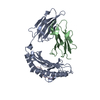 1bz9C 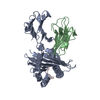 1hhjS S: Starting model for refinement C: citing same article ( |
|---|---|
| Similar structure data |
- Links
Links
- Assembly
Assembly
| Deposited unit | 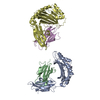
| ||||||||||
|---|---|---|---|---|---|---|---|---|---|---|---|
| 1 | 
| ||||||||||
| 2 | 
| ||||||||||
| Unit cell |
| ||||||||||
| Noncrystallographic symmetry (NCS) | NCS oper: (Code: given Matrix: (-0.914367, 0.404851, -0.005413), Vector  : : |
- Components
Components
| #1: Protein | Mass: 31854.203 Da / Num. of mol.: 2 Source method: isolated from a genetically manipulated source Source: (gene. exp.)   Homo sapiens (human) / Cellular location: CELL SURFACE Homo sapiens (human) / Cellular location: CELL SURFACE Cell membrane / Plasmid: PLM1 / Cellular location (production host): CYTOPLASM / Production host: Cell membrane / Plasmid: PLM1 / Cellular location (production host): CYTOPLASM / Production host:   Escherichia coli (E. coli) / Strain (production host): BL21 PLYSS / References: UniProt: P01892, UniProt: P04439*PLUS Escherichia coli (E. coli) / Strain (production host): BL21 PLYSS / References: UniProt: P01892, UniProt: P04439*PLUS#2: Protein |  Beta-2 microglobulin Beta-2 microglobulinMass: 11879.356 Da / Num. of mol.: 2 Source method: isolated from a genetically manipulated source Source: (gene. exp.)   Homo sapiens (human) / Plasmid: PLM1 / Cellular location (production host): CYTOPLASM / Production host: Homo sapiens (human) / Plasmid: PLM1 / Cellular location (production host): CYTOPLASM / Production host:   Escherichia coli (E. coli) / Strain (production host): BL21 PLYSS / References: UniProt: P61769 Escherichia coli (E. coli) / Strain (production host): BL21 PLYSS / References: UniProt: P61769#3: Protein/peptide | Mass: 1049.263 Da / Num. of mol.: 2 Source method: isolated from a genetically manipulated source References: UniProt: Q9NPA0*PLUS #4: Water | ChemComp-HOH / |  Water Water |
|---|
-Experimental details
-Experiment
| Experiment | Method:  X-RAY DIFFRACTION / Number of used crystals: 1 X-RAY DIFFRACTION / Number of used crystals: 1 |
|---|
- Sample preparation
Sample preparation
| Crystal | Density Matthews: 2.5 Å3/Da / Density % sol: 50.8 % | ||||||||||||||||||||||||||||||||||||||||||
|---|---|---|---|---|---|---|---|---|---|---|---|---|---|---|---|---|---|---|---|---|---|---|---|---|---|---|---|---|---|---|---|---|---|---|---|---|---|---|---|---|---|---|---|
Crystal grow | Method: vapor diffusion, hanging drop / pH: 6.5 Details: PROTEIN WAS CRYSTALLIZED IN THE HANGING DROP VAPOR DIFFUSION METHOD. THE RESERVOIR SOLUTION CONTAINED 12-16% PEG6000, 6% DIOXANE IN 25MM MES BUFFER, PH6.5. THE HANGING DROP WAS A 1:1 MIXTURE ...Details: PROTEIN WAS CRYSTALLIZED IN THE HANGING DROP VAPOR DIFFUSION METHOD. THE RESERVOIR SOLUTION CONTAINED 12-16% PEG6000, 6% DIOXANE IN 25MM MES BUFFER, PH6.5. THE HANGING DROP WAS A 1:1 MIXTURE OF THE RESERVOIR SOLUTION AND THE PROTEIN SOLUTION WHICH CONTAINED 10MG/ML PROTEIN IN 25MM MES BUFFER, PH6.5., vapor diffusion - hanging drop | ||||||||||||||||||||||||||||||||||||||||||
| Components of the solutions |
| ||||||||||||||||||||||||||||||||||||||||||
| Crystal grow | *PLUS Method: vapor diffusion, hanging drop | ||||||||||||||||||||||||||||||||||||||||||
| Components of the solutions | *PLUS
|
-Data collection
| Diffraction | Mean temperature: 100 K |
|---|---|
| Diffraction source | Source:  ROTATING ANODE / Type: RIGAKU RU200 / Wavelength: 1.5418 ROTATING ANODE / Type: RIGAKU RU200 / Wavelength: 1.5418 |
| Detector | Type: RIGAKU RAXIS IIC / Detector: IMAGE PLATE / Date: May 15, 1997 / Details: MIRRORS |
| Radiation | Monochromator: NI FILTER / Protocol: MONOCHROMATIC / Monochromatic (M) / Laue (L): M / Scattering type: x-ray |
| Radiation wavelength | Wavelength : 1.5418 Å / Relative weight: 1 : 1.5418 Å / Relative weight: 1 |
| Reflection | Resolution: 2.5→30 Å / Num. all: 29804 / Num. obs: 29804 / % possible obs: 90.9 % / Observed criterion σ(I): 0 / Redundancy: 2.6 % / Biso Wilson estimate: 23.42 Å2 / Rmerge(I) obs: 0.083 / Net I/σ(I): 16.6 |
| Reflection shell | Resolution: 2.5→2.59 Å / Redundancy: 1.8 % / Rmerge(I) obs: 0.176 / Mean I/σ(I) obs: 6.5 / % possible all: 70.8 |
| Reflection | *PLUS Num. measured all: 77499 |
| Reflection shell | *PLUS Highest resolution: 2.5 Å / % possible obs: 70.8 % |
- Processing
Processing
| Software |
| ||||||||||||||||||||||||||||||||||||||||||||||||||||||||||||||||||||||||||||||||||||
|---|---|---|---|---|---|---|---|---|---|---|---|---|---|---|---|---|---|---|---|---|---|---|---|---|---|---|---|---|---|---|---|---|---|---|---|---|---|---|---|---|---|---|---|---|---|---|---|---|---|---|---|---|---|---|---|---|---|---|---|---|---|---|---|---|---|---|---|---|---|---|---|---|---|---|---|---|---|---|---|---|---|---|---|---|---|
| Refinement | Method to determine structure : :  MOLECULAR REPLACEMENT MOLECULAR REPLACEMENTStarting model: PDB ENTRY 1HHJ Resolution: 2.5→30 Å / SU ML: 0.32 / Cross valid method: THROUGHOUT / σ(F): 0 / ESU R: 3.44 / ESU R Free: 0.39
| ||||||||||||||||||||||||||||||||||||||||||||||||||||||||||||||||||||||||||||||||||||
| Displacement parameters | Biso mean: 37.06 Å2
| ||||||||||||||||||||||||||||||||||||||||||||||||||||||||||||||||||||||||||||||||||||
| Refinement step | Cycle: LAST / Resolution: 2.5→30 Å
| ||||||||||||||||||||||||||||||||||||||||||||||||||||||||||||||||||||||||||||||||||||
| Refine LS restraints |
| ||||||||||||||||||||||||||||||||||||||||||||||||||||||||||||||||||||||||||||||||||||
| Refinement | *PLUS Lowest resolution: 30 Å | ||||||||||||||||||||||||||||||||||||||||||||||||||||||||||||||||||||||||||||||||||||
| Solvent computation | *PLUS | ||||||||||||||||||||||||||||||||||||||||||||||||||||||||||||||||||||||||||||||||||||
| Displacement parameters | *PLUS | ||||||||||||||||||||||||||||||||||||||||||||||||||||||||||||||||||||||||||||||||||||
| Refine LS restraints | *PLUS
|
 Movie
Movie Controller
Controller



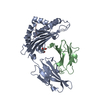

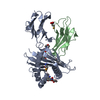
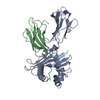
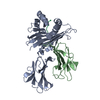
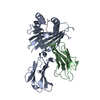
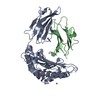

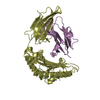
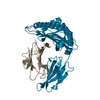
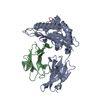
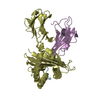
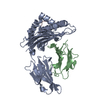

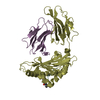
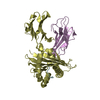
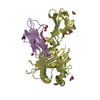
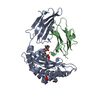
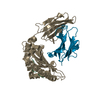
 PDBj
PDBj



